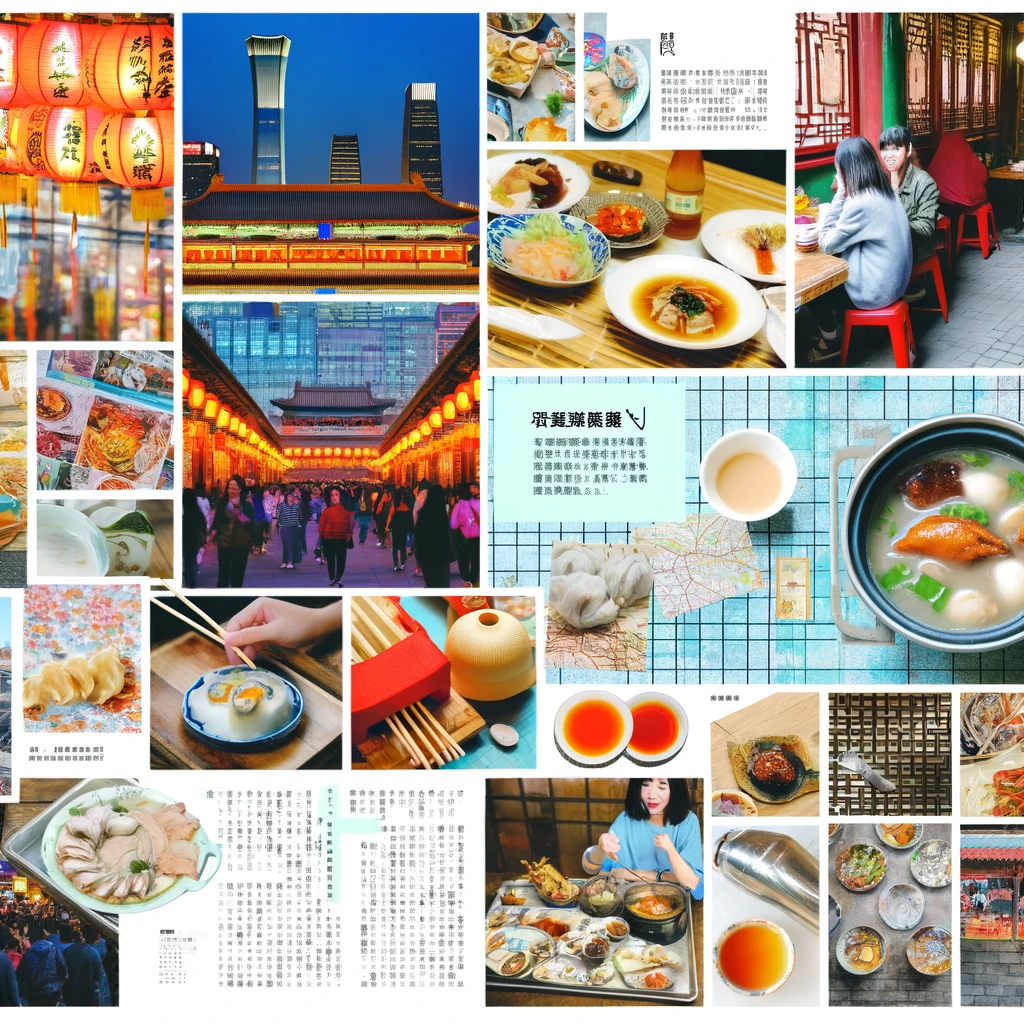Top Things to Eat in Beijing: 10 Must-Try Local Delicacies

1. Peking Duck
Peking Duck, a renowned Beijing delicacy, is celebrated for its delectable combination of crispy skin and succulent meat. The traditional method involves roasting the duck in a wood-fired oven to achieve the perfect texture and flavor profile that has made it an iconic dish worldwide.
This dish is commonly accompanied by thin pancakes, fresh scallions, and flavorful hoisin sauce which complement the rich flavors of the duck impeccably. The process of serving Peking Duck with these condiments adds an interactive element to dining as diners assemble their own wraps according to their preferences.
The history behind Peking Duck dates back to the Qing Dynasty where it was served exclusively in royal feasts before becoming widely available across Beijing. This culinary treasure offers not just a meal but an experience that encapsulates centuries of tradition and culinary expertise unique to this vibrant city.
2. Jiaozi (Chinese Dumplings)
A popular street food in Beijing, jiaozi are dumplings filled with a variety of ingredients like pork, shrimp, or vegetables. These dumplings are typically boiled or pan-fried to achieve a deliciously chewy texture that is irresistible to many.
Jiaozi holds cultural significance and is often enjoyed during Chinese New Year as a symbol of good luck and prosperity. The act of making and eating jiaozi during this time signifies family unity and the welcoming of wealth and happiness for the upcoming year.
The versatility of jiaozi allows them to be customized based on personal preferences, making them suitable for various tastes ranging from savory to spicy fillings. This adaptability has contributed significantly to their popularity not only in Beijing but worldwide as well.
Whether you prefer your jiaozi steamed, boiled, or pan-fried, these delectable dumplings offer a delightful culinary experience that encapsulates the essence of traditional Chinese cuisine while providing a satisfying meal option for locals and tourists alike.
3. Zhajiangmian (Beijing Noodles with Soybean Paste)
A classic Beijing noodle dish, Zhajiangmian features a delectable combination of savory soybean paste, minced pork, and fresh vegetables. The rich sauce paired with chewy noodles creates a delightful contrast in flavors and textures.
Customization is key when enjoying Zhajiangmian; you can elevate this food by adding toppings such as cucumber or shredded carrots to suit your taste preferences. This flexibility allows both locals and visitors to personalize their culinary experience in Beijing.
The main ingredients of Zhajiangmian, including the soybean paste and minced pork, contribute significantly to its robust flavor profile. The incorporation of fresh vegetables not only enhances the dish’s nutritional value but also adds a refreshing crunch with every bite.
For those seeking an authentic taste of Beijing cuisine, indulging in a bowl of Zhajiangmian offers a glimpse into the traditional flavors cherished by locals for generations. Whether exploring the bustling streets or visiting iconic landmarks like the Forbidden City, savoring this beloved noodle dish is a must-do culinary experience during your time in Beijing.
4. Mongolian Hotpot
A communal dining experience awaits you with Mongolian Hotpot in Beijing. Diners engage in the interactive process of cooking their own ingredients in a simmering pot of flavorful broth, creating a personalized culinary adventure.
Thinly sliced meats, fresh vegetables, and an array of dipping sauces elevate the hotpot experience to new heights. This method allows for customization based on individual preferences, making it a versatile choice for both meat lovers and vegetarians alike.
Originating from Inner Mongolia but now deeply embedded in Beijing’s food culture, Mongolian Hotpot has found its way into the hearts – and stomachs – of locals and travelers alike. The vibrant colors of the ingredients add not only to the visual appeal but also enhance the overall taste profile.
Whether you venture into traditional hutong restaurants or modern establishments specializing in this dish, be prepared for a boiling pot filled with delectable items waiting to be cooked to perfection right at your table.
5. Beijing Roast Pork
Known as “sliced belly pork” or “siu yuk,” this dish is made by roasting marinated pork belly until crispy on the outside and juicy on the inside. The process of slow roasting allows the fat to render, creating a crunchy texture while keeping the meat succulent.
Beijing roast pork is often seasoned with spices like five-spice powder and Sichuan peppercorns for an aromatic and flavorful profile. These seasonings add depth to the savory taste of the pork, making each bite a rich experience.
Served with steamed buns or rice, Beijing roast pork offers a satisfying meal that balances textures and flavors. The softness of steamed buns complements the crispiness of the pork skin, providing a delightful contrast in every mouthful.
Pairing this dish with pickled vegetables or fresh greens can further enhance its overall enjoyment by adding brightness and crunchiness to each bite. This traditional Beijing delicacy encapsulates centuries-old culinary expertise that continues to captivate both locals and visitors alike.
6. Donkey Burgers
Donkey burgers, a unique street food in Beijing, consist of succulent donkey meat enveloped within a bun. The preparation involves marinating the meat and slow-cooking it to perfection, resulting in enhanced tenderness and flavor that sets it apart from typical burgers.
The distinctive taste of donkey burgers is a blend of savory notes with a slight gamey undertone, offering an intriguing culinary experience for adventurous food enthusiasts seeking something beyond traditional options.
7. Guotie (Potstickers)
Pan-fried dumplings with a crispy bottom and juicy filling, typically pork and cabbage-based, define guotie. The name “guotie” reflects the stickiness of the dumplings due to frying, creating a delightful contrast in textures.
These delectable potstickers are commonly accompanied by a dipping sauce comprising soy sauce, vinegar, and chili oil. This flavorful blend enhances the savory taste of the guotie while adding a hint of tanginess to each bite.
8. Aiwowo (Steamed Rice Cakes with Sweet Fillings)
Traditional Beijing snacks, aiwowo are crafted from rice flour and boast delectable sweet fillings like red bean paste or jujube paste. The steaming process ensures a delightful soft and chewy texture that captivates the taste buds.
Aiwowo serves as a popular dessert choice in Beijing, often savored during festivals or as a delightful sweet indulgence. These treats offer not just a burst of sweetness but also showcase the intricate culinary culture of Beijing through their preparation and flavors.
The combination of glutinous rice flour and sugary fillings creates an irresistible treat that appeals to those with a penchant for authentic Chinese desserts. Whether enjoyed on special occasions or simply as a daily delight, aiwowo encapsulates the essence of traditional Beijing cuisine.
With each bite into these delectable steamed rice cakes filled with rich pastes, one can experience the harmonious blend of textures and flavors that make aiwowo an iconic part of Beijing’s food scene.
9. Lu Zhu Huo Shao (Wheat Gluten and Meat Stew)
A hearty stew combining wheat gluten, tender meat, and an array of vegetables creates a flavorful dish that epitomizes Beijing’s culinary scene. Slow-cooked for hours, this stew allows the ingredients to intermingle, resulting in a rich and harmonious blend of flavors.
This traditional dish is particularly cherished during Beijing’s colder months when its warmth and heartiness offer comfort like no other meal can. The combination of the chewy texture from the wheat gluten, the tenderness of the meat, and the freshness of vegetables makes Lu Zhu Huo Shao a well-rounded option for those looking for a satisfying dining experience.
Lu Zhu Huo Shao stands out not only for its taste but also for its cultural significance in Beijing cuisine. It represents a perfect harmony between different elements—an embodiment of how Chinese cooking often balances flavors and textures to create memorable dishes that captivate both locals and visitors alike.
10. Tanghulu (Candied Fruit Skewers)
Skewered fruits coated in a sugary glaze that solidifies into a crispy shell, tanghulu is a traditional snack commonly found on Beijing’s snack streets. Strawberries, grapes, and hawthorn berries are among the popular choices for this delightful treat. The contrast of the sweet syrup with the natural tartness of the fruit creates a harmonious blend of flavors that appeals to locals and tourists alike.
Tanghulu stands out as a beloved street food due to its unique combination of textures and tastes. The process of making tanghulu involves dipping fresh fruits into hot sugar syrup multiple times until it forms a glossy coating that hardens upon cooling. This method not only preserves the fruit but also enhances its flavor by creating an irresistible crunchy exterior.
The artistry behind crafting tanghulu lies in achieving the perfect balance between sweetness and acidity while ensuring each piece retains its juiciness beneath the crisp shell. This snack embodies Beijing’s culinary culture, showcasing how simple ingredients can be transformed into an indulgent delight enjoyed by many on bustling snack-filled streets.
Frequently Asked Questions
What is Peking Duck and why is it a must-try in Beijing?
Peking Duck is a famous dish with crispy skin and tender meat, traditionally served with pancakes, scallions, and hoisin sauce. It’s a culinary delight that represents Beijing’s rich gastronomic heritage.
Where can I find the best Jiaozi (Chinese Dumplings) in Beijing?
For authentic Jiaozi experience, head to local dumpling houses like Baoyuan Jiaozi Wu or Din Tai Fung. These places offer a variety of fillings and cooking styles to tantalize your taste buds.
What makes Mongolian Hotpot popular among locals and tourists in Beijing?
Mongolian Hotpot allows diners to cook various meats, vegetables, and noodles at their table in a flavorful broth. It’s not just a meal; it’s an interactive dining experience that brings people together over shared cooking.
How would you describe the taste of Donkey Burgers compared to traditional beef burgers?
Donkey Burgers have a unique flavor profile – slightly gamey yet savory with tender meat packed between crispy buns. The taste offers an adventurous twist for those seeking new culinary experiences beyond conventional beef burgers.
Can you explain the significance of Tanghulu (Candied Fruit Skewers) in Chinese culture?
Tanghulu symbolizes sweetness and good luck in Chinese culture. The vibrant colors of candied fruit skewered on sticks are not only visually appealing but also represent wishes for happiness and prosperity when enjoyed during festive occasions.



